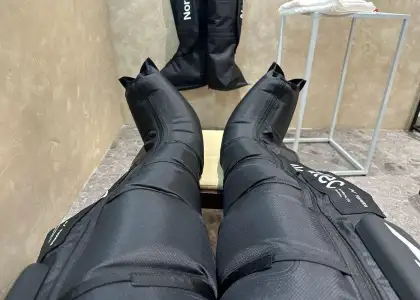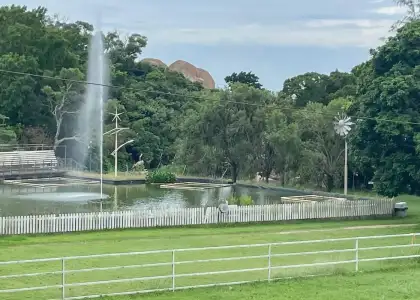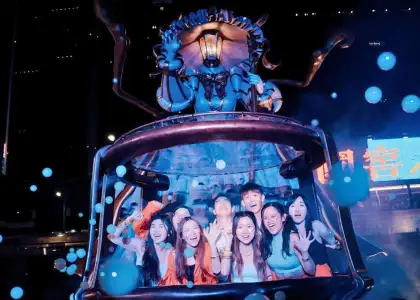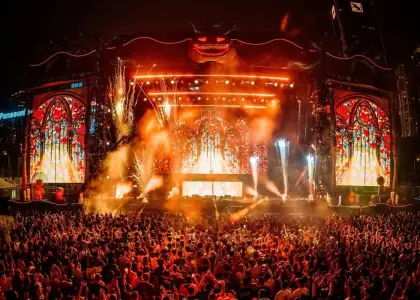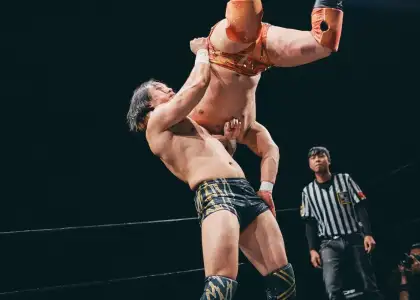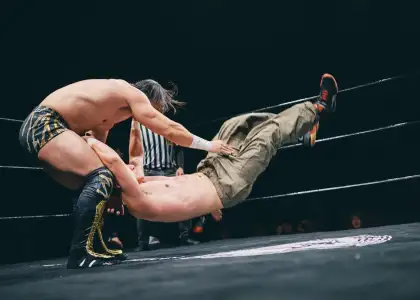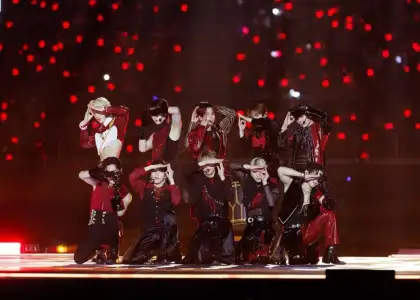The Stallery’s Ernest Chang Evolves His Art with the Colours of Hong Kong

From the dazzling yellow brick building in the heart of Wan Chai’s historic cluster to the multicoloured works of art inside, Ernest Chang is an artist who imprints vibrant bursting hues in his wake. Embedded into all of his pieces is a perspective that’s deeply informed by his experience of the world – one that washes out any traces of the colours red and green.
Founder of local art hub The Stallery, and famed for his tongue-in-cheek multi-format works, Ernest has gained a reputation in Hong Kong and beyond for pieces that smash together asynchronous cultural references, with undercurrents of commentary on our zeitgeist. Having deuteranopic colour blindness, his creations are chock full of in-your-face colour contrasts and strong compositions.
Giving us a tinted glimpse into how Hong Kong has coloured his practice, discover how Ernest has evolved his vision into a storied career as one of the city’s most iconic contemporary pop artists, and how he has manifested a unique artistic community through The Stallery.

How did you transform your colour-blindness into an asset?
In school, mixing colours was difficult for me, so that pushed out painting from early on. I ended up with photography and felt like I could just use the world’s colours and not just have to mix my own. As any creative would tell you, photography is a good gateway to exploring how you see things, that’s why I picked it up. I got drawn to taking photos of people and mainly focused on fashion and portrait photography at first.
I had a business going mostly for portraiture and headshots in my signature ‘everything in black and white,’ but over the years I got a lot of feedback where people wanted colour. So ultimately, they were complaining about how they looked a little orange or green in their skin tones because I was colour-correcting them wrong!
I thought, ‘Maybe it’s time for me to go back to where I first started in art,’ which was drawing anime and cartoon characters, because as a kid I would watch so many of these things and I would always be copying them. I felt like I needed to go back to my original inspiration.
So that’s what I’ve been doing for the past seven years. My practice has been mostly about this type of contemporary pop culture mixed with classical art. I started clashing these ideas together because in the world that we live in, and also in the generation we grew up in, there’s so much dichotomy and ‘bipolarism’ that it became what my art is about – those clashing two poles.
Has your style evolved since you came to Hong Kong?
I wouldn’t necessarily say my style, form and colour scheme necessarily came out of a Hong Kong cultural context, but there’s finding the confidence to clash things that are new and old. I see it all the time in Hong Kong and somehow it just works artistically for me, [so] that really inspired me.
I see it all the time in Wan Chai. It’s like having the Blue House and the oldest post office right next to us, while [the city is] always building new things, it’s just this sense of modern mixing with tradition. This is what Hong Kong brings out and what changed my practice.
Even in the EnChroma art show that I had shown at The Stallery with my collective, Workers of Art (WoA), a lot of the artists were older than 55 [years old]. A lot of them have a different set of philosophy and artistic ideas coming from, say, a calligraphy background or a traditional landscape painting background. You can see Chinese influence in it, but it mostly felt grounded in Western art history. I think that’s what Hong Kong brings, the city can keep up with the times, but it still drags along this bag of tradition.

Did you ever feel restricted by “traditional” modes of art? How did you navigate their rules and conventions?
It’s the idea that we aren’t represented in Western art. Most institutions in the art world are built on Western art, and we miss a lot of chances to talk about Asian culture or even Chinese culture. If you would like to talk about that you would have to go to a specific type of museum, for a specific type of niche art – and I don’t think that [Asian art] should be niche.
That’s sort of what triggered me to do my series, ‘Famous by Proxy.’ I was going through Europe and seeing all these pieces by the masters, Rembrandts and all that. They’re stunning and incredible pieces of art, no doubt, but at the same time, after all these hundreds of years, we still haven’t found the equivalent of something as famous as ‘The Night Watch’ in Asian art. It’s not comparable when you can name hundreds of Western paintings but like ten Asian paintings.
For me, the ‘Famous by Proxy’ series is about using something that was already famous and injecting it with symbols of Asian culture and all the things that we like. By flipping these icons, we find it funny, because we’ve been looking at things that are so ridiculous, but we accept them because they’re in our history books. You accept this as ‘good art’ because you’ve seen it so many times, but I hope when people see some form of Asian culture in it, their values of art will be questioned.
Speaking of shifting perspectives, what was it like being able to see the world in full colour for the first time with the enChroma lenses?
Being able to see colour in a more vibrant way, I’m trying to go back to basics and understand colour at its foundational level, then I can start using them in a new way that I’ve never been able to perceive with colours I couldn’t see before – browns, greys, pinks. I want to use colours that constantly confuse me, and with these glasses, hopefully be able to produce a series.
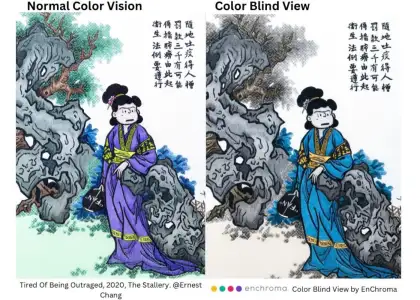
Did the glasses change how you approached your artistic process?
When I didn’t have the EnChroma glasses, I based my understanding of colour on Pantone codes or hex codes – things that are quite mathematical. It felt like a lot of fine artists would be snobbish about using digital mediums to produce work, but for me, it’s essential to my art-making. Without it, I wouldn’t be able to make such complex pieces with so much colour.
There is this kind of gatekeeping in the art world. “Real art is oil on canvas” or something like that, as opposed to an iPad drawing. I think it’s slowly changing, but I’m showing more of the process so that I can help people understand that it’s not just done in a click. Telling people about the artmaking process helps them grow [their understanding] with the times.
I grew up in an age where we had to learn a completely new set of skills, while also fighting against an old set of skills, this push and pull. I feel like that is why we have to show more transparency, showing the whole process [of our art-making], or some people are just going to think ‘Oh it was just produced in a factory!’
A lot of your exhibitions incorporate an element of this art-making ‘process,’ interactivity, or are also paired with workshops. Do you believe that aspect of participation is essential to art, and why?
The Stallery is called The Stallery because it’s both a studio and a gallery.
In Hong Kong, the rent is so high and all the [operating] costs are so high, it’s super rare someone can be in the position that I am. I’m very blessed to have all this to support my art career, and that’s why I try to involve the public as much as possible.
Now I’ve changed my studio practice to be more at home, but a year or two ago I would just be in [The Stallery] silk-screening, and it was open for people to come in. They did, so they would come in while I would be working, walk around, and then leave. My process and my artwork are both as important as each other, not just the final piece.
How would you describe the artistic and curatorial vision behind The Stallery?
I’m trying to bring back the modern atelier. Well, I mean I’m romanticizing a time that I’ve never lived in, but it was that golden era of artists in workshops where they also did salon-style shows with their friends. That’s what I want in Hong Kong.
I don’t believe in galleries that act like the artwork is just a product in a supermarket for you. Like it’s packaged and delivered without any kind of understanding of the craft or skill that goes into it. Seeing the places where works are made, you understand that these things are human endeavours, and they’re all based on passion, energy, blood, and tears. You know it’s not something that comes out of thin air just to get delivered and hung up on a white wall.
Seeing all these facets in art-making is more messy, and I don’t think the white wall galleries would like that, because they’re about selling to luxury clients and cleaning it up for everyone. But for me, art should be down-up, instead of up-down. It should be more grassroots, it should be influencing everyone so that they can influence me as well.

So, who is The Stallery for?
It’s really for the weirdos, like me. People that feel like the Hong Kong art and culture scene have left them out. It’s time to change up the demographic of gallery visitors.
It's way more communal here, and that’s why I kind of picked the Wan Chai area. For me, it’s about not having so much of a ‘bougie’ look [to The Stallery], so that people aren’t scared to come in and explore!
What do you hope to see in the future of Hong Kong’s art scene, and how would you introduce it?
I’ve made a lot of work for the past 6 years, I’ve just been doing shows non-stop, and I feel like I need to use the clout that I have built over time to promote other people as well.
The gallery is not just about me, the gallery is about the community. So by connection or by proxy, there’s more respect for the other artists in Hong Kong. At the end of the day, if I can show the Hong Kong audience that there’s a new atmosphere rising up in the air, maybe they will be able to accept more new art.
This interview has been edited for length and clarity.
Location: The Stallery, G/F, 82A Stone Nullah Lane, Wan Chai, Hong Kong
Keep up with Ernest on Instagram at @iamernestchang and learn more about The Stallery by clicking here.
Enjoyed this article? Check out our previous Artist Spotlight profiles here.
Get the latest curated content with The Beat Asia's newsletters. Sign up now for a weekly dose of the best stories, events, and deals delivered straight to your inbox. Don't miss out! Click here to subscribe.
























